Minnie Belle Aloe is one of the most popular aloe species in the aloe genus. The Aloe genus itself has about 500 species, and they are very popular among gardeners. Aloe plants are capable of fulfilling any gardening requirements of yours. They would perfectly fit in any succulent garden and thrive well. So, do you wish to learn about this plant? then keep reading this article.
Minnie aloes are native to South Africa. However, this is not an endangered plant, and you can easily spot them due to their unusually wide distribution. They usually grow from other plants’ roots. You would commonly find them in areas with hot and dry weather conditions. Minnie Belle Aloe is popular as an ornamental plant as well. Further, there are so many other uses for these plants.
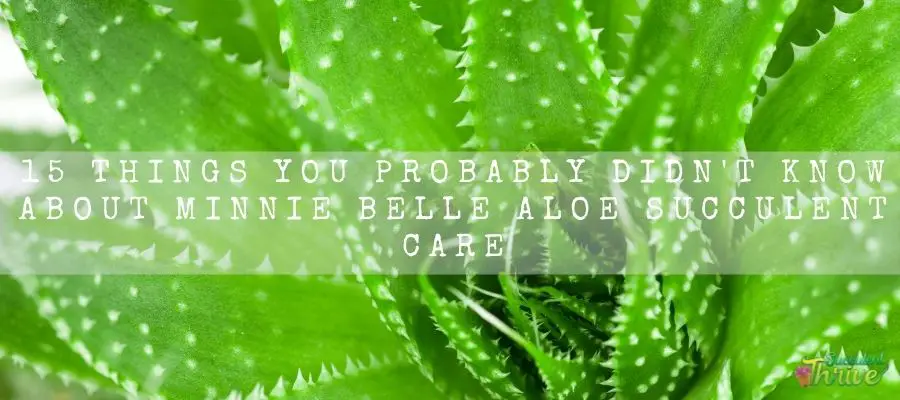
One look care guide
| Botanical Name | Aloe vera |
| Common Name | Minnie belle variety |
| Plant Type | Succulent |
| Mature Size | 4 inches in height. 12-15 inches in width. |
| Sun Exposure | Full sunlight to partial sunlight |
| Soil Type | Well-draining |
| Soil pH | 7.0-8.5 (Acidic – neutral) |
| Bloom Time | Late spring and summer |
| Flower Color | Deep red |
| Hardiness Zones | USDA hardiness zones 9 through 11 |
| Native Area | South Africa |
| Toxicity | No report |
| Average price | 6 – 10 $ |
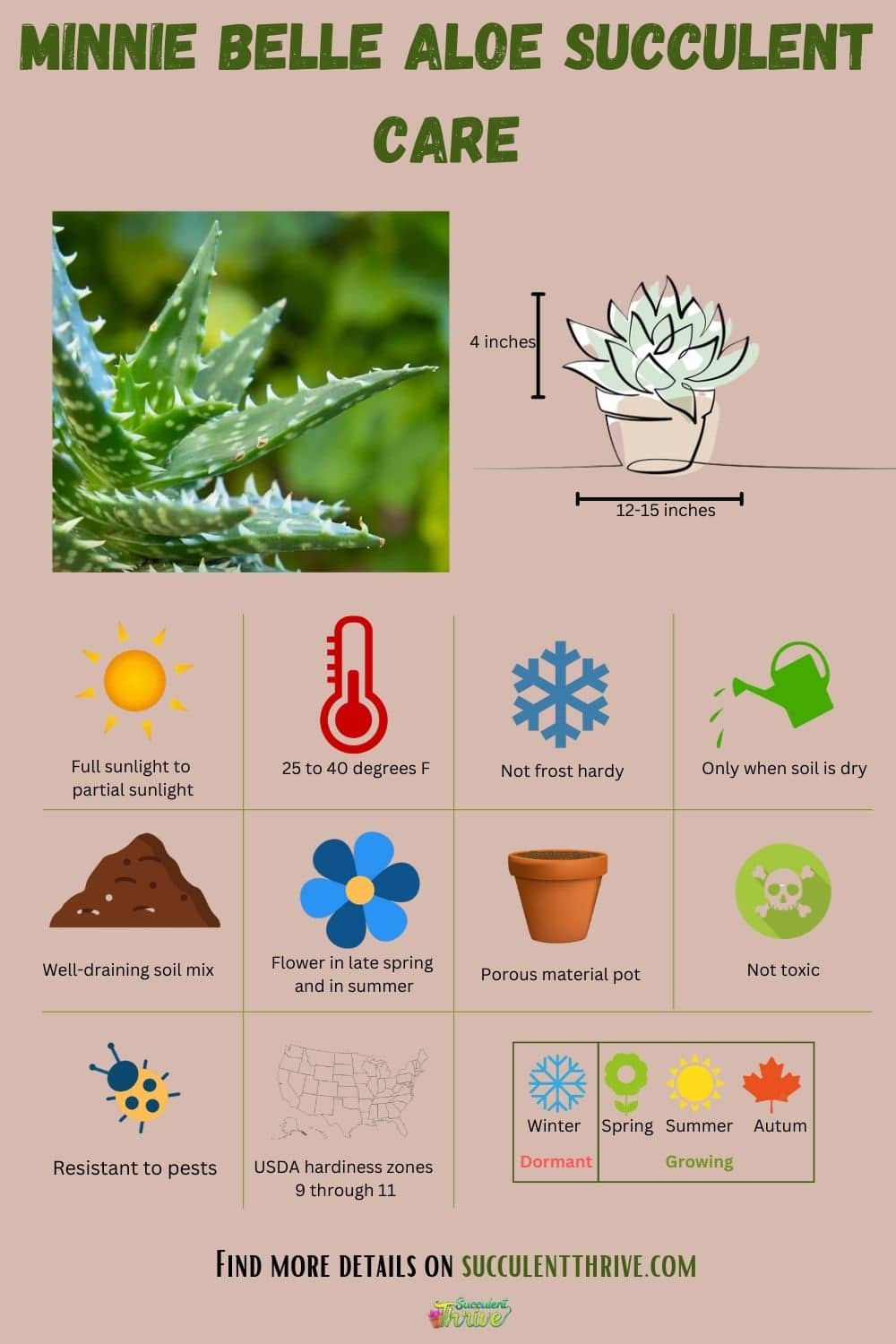
How do I identify Minnie Belle aloe?
You could identify the Minnie belle aloe by looking at its foliage. Usually, you can find them in a bright green color along with spots in white. In addition to that, you could find translucent white spikes on their leaf’s edges. Their flowering would also help you identify these plants during late spring and summer. In fact, they would produce flowers in a bright, deep red color. They would tend to take a bell shape.
Pollinators such as bees, butterflies, and hummingbirds are attractive to them. Those blooms would usually arise from stems and not from any branches.
Minnie belle aloe usually tends to resemble a tree. In terms of the sizes, they would rise to 4 feet in height. They would further consist of one stem. Alternatively, they could have a trunk that tends to take a round or spherical shape. To further elaborate on their leaves, they would be oval shaped. However, you cannot spot any teeth or serrations on their leaves.
Minnie belle aloe leaves are somewhat smaller in size when compared to the rest of other Aloe leaves.
This is one more characteristic that makes it even easier to identify these plants. You could spot the green leaves on the upper part of the plant. On the other hand, the leaves in the bottom part of the plant are yellow in color. Minnie belle aloe will have short roots that are brown in color.
Size
They would rise to 4 inches in height. On the other hand, plant spread would be about 12-15 inches.
How do you take care of Minnie Belle aloe?
Light Requirement
Minnie belle Aloe prefers to grow in full sunlight to partial sunlight. As such, if you are growing them outdoors, place them in a spot where they can gain bright sunlight, ideally in the morning, and partial sunlight in the afternoon. Having said that, refrain from exposing them to direct sunlight, though.
On the other hand, when you grow them as indoor plants, you need to grow them near a bright, sunny window. They do not thrive well in low light. As such, you need to be vigilant about providing them with adequate sunlight when growing them indoors.
Temperature and humidity
Minnie belle aloe would not thrive in temperatures below -1 degrees Celsius. Further, you need to protect yourself from hard frost conditions as well. As such, if you have grown them outdoors, it is best to shift them indoors when there is any forecast of frost conditions. Moreover, when you bring them indoors, ensure you do not locate them closer to cold drafts or extremely heated places.
Is it cold hardy?
Minnie belle aloe are frost hardy to -1 degrees Celsius.
Zone
Minnie belle aloe are hardy in USDA hardiness zones 9 through 11.
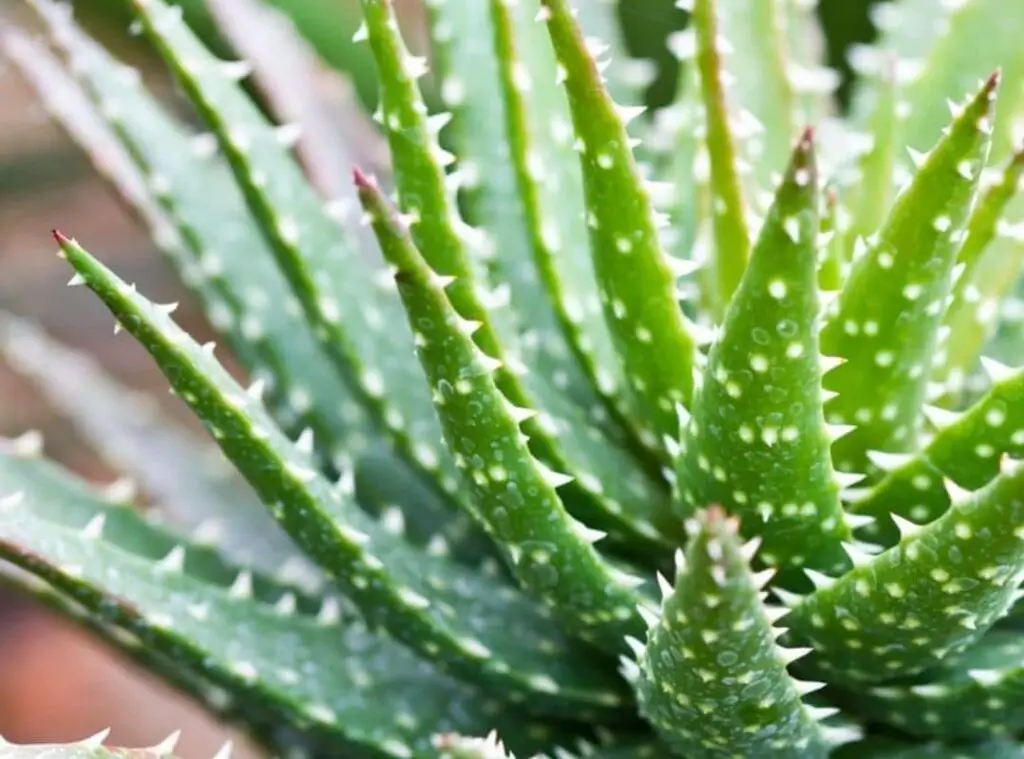
Watering Requirement
You need to make sure that you are watering them appropriately when taking care of these plants.
Minnie belle aloe used to grow in hot and dry weather conditions, and you should be extra careful to avoid over watering these beloved plants.
Minnie belle aloe has conserved water in their leaves, and is why you should not supply them with excess water at any given time. You may practice the soak and dry method when watering them so that you can avoid any potential over-watering situation.
You must soak the soil in water and then allow it to dry. You need to commence watering them only when their soil is dry.
In addition to that, you need to ensure you are growing them in a pot that has a draining hole in the bottom so that the excess water can flow through. Not only that, but you should also grow them in a well-draining soil mix as well.
Soil Requirement Type / pH
Minnie belle aloe would require a well-draining soil mix to grow vigorously and stay healthy. As aforesaid, your soil mix needs to have good drainage so that there will not be any waterlogged conditions within the soil. The best is to grow them in a cactus soil mix or a succulent soil mix. The ideal pH of the soil should be 7.0–8.5 (Acidic – neutral). Avoid growing them in a regular soil mix, as it will not help the plant to thrive well.
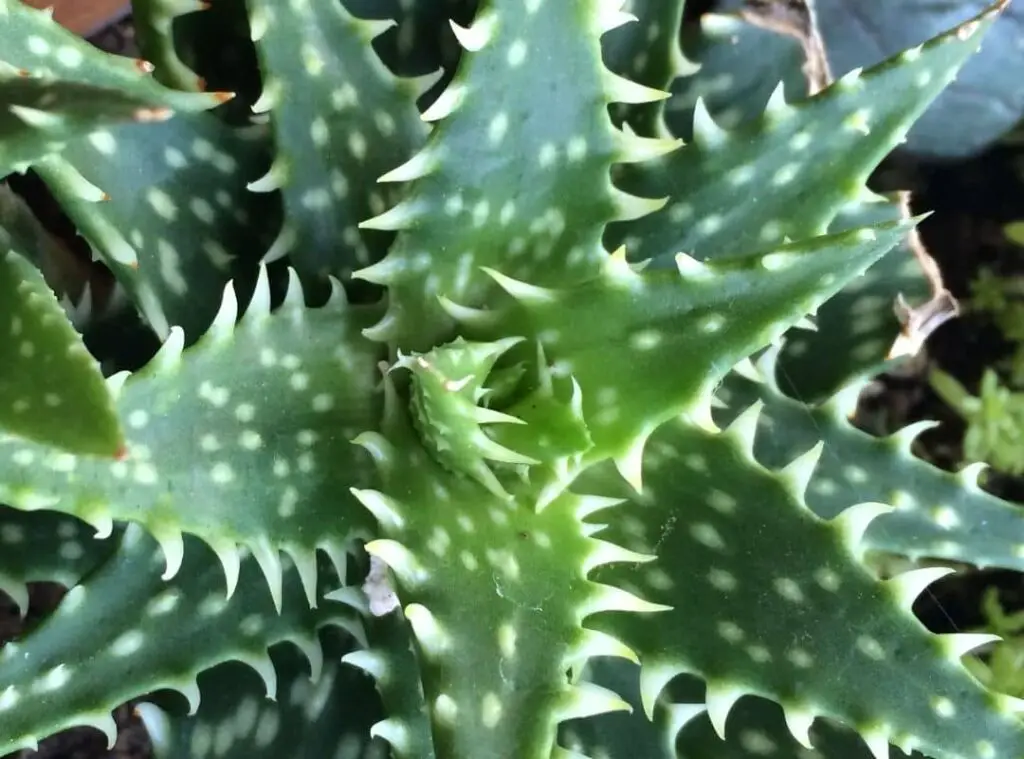
Flowering and Fragrance
Minnie belle aloe produces deep red colored blooms. Further, they would tend to take a bell shape as well. Those blooms would usually arise from the stem itself. They should bloom in late spring and early summer.
Further they are attractive for pollinators such as bees, butterflies etc. The blooms of the Minnie belle aloe are hermaphrodite. Those flowers consist of both male and female reproductive organs.
Pot size Potting and Repotting
Minnie belle aloe would require a pot which is ideally made with a porous material. Best recommended is to grow them in Terracotta pots. On another note, make sure your pot has a draining hole in the bottom unless excess water cannot move through from the pot.
When it comes to repotting, you do not need to repot them quite often. Further, you may report them once you purchase them from stores.
To do that, you should first take out the plant from the pot. If you spot any pups that have formed, you may remove them from the root mass. In case if your plant has become root bound, you may snip off the roots whilst using a sharp and clean knife. Do not worry about trimming the roots as it would not harm the plant. When you divide the plants, you need to leave them in a warm and dry place. That will help to heal the wounds. After that you may plant them in new pots.
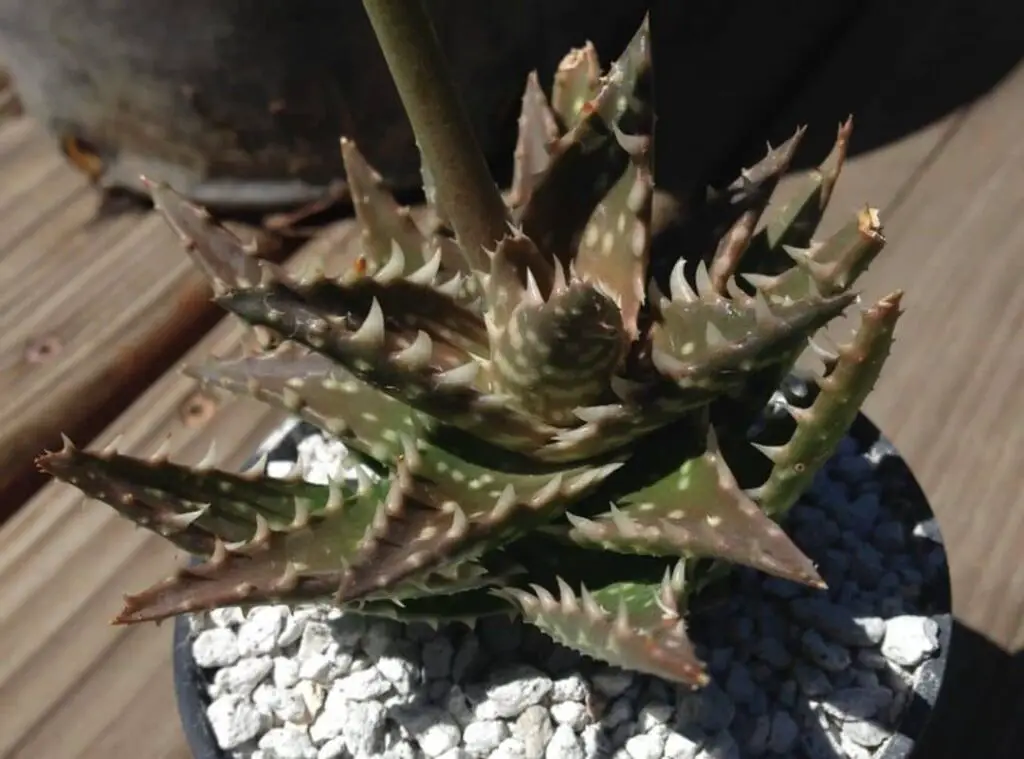
Where to Plant
You could commonly spot them being planted as ornamental plants. You may place them in gardens or in landscaping as well. You could grow them in small clusters so that they would be useful as a natural fence or a hedge. This is something very common among gardeners since these plants are resistant towards pests. Furthermore, they are easy to care for. Their flowering is an added advantage to grow them in such a manner.
Fertilizer and time of year
Minnie belle aloe are not dependent on fertilizers since they can thrive with the nutrients available in their soil mix. However, as they grow in the same pot, nutrients will be depleting. In that circumstance feeding them would be quite useful for their growth.
If you think your plant is running out of nutrients, you may consider feeding them once every fortnight. You could fertilize them during spring and in summer. To do that you may use an organic liquid fertilizer. You need to adhere to the prescribed instructions when feeding them. You should skip feeding the Minnie belle aloe in winter since that is their dormancy season and they would be in their relaxing mode during this time.
Dormancy
Minnie belle aloe are winter dormant plants. During their dormancy you should minimize watering and not feed them at all.
Other plants Pairs Well With
Minnie belle aloe would make great plants along with strawberry plants, sow thistle Scented geraniums etc.
Can it be toxic to pets
There was no record of their toxicity. But since some aloe are toxic to cats and dogs, it is better to kept this plant unreachable to pets.
Common bugs and illnesses
Minnie belle aloe are resistant to pests. Having said that, they could still come across root rot which could be a real menace for the survival of these plants. This is quite common to spot in soggy soil.
As such, if you grow these plants as outdoor plants, you need to grow them in sandy or gravelly ground.
That will make sure that excess water is not retained, and it is following through. Further when you grow them as indoor plants, ensure that you are growing them in a cactus soil mix or in a succulent soil mix. In addition to that, you should apply the soak and dry method so that you will not end up over watering your beloved aloe plant.
Moreover, it is very important that you conduct regular check ups on your plants so that you could identify if there are any early signs of any disease.
Special Care tips
It is important that you provide the basic right growing conditions for these plants so that they can thrive well. In addition to that, make sure that you keep the plants surrounding the area clean.
Not only that but also, as aforesaid you need to protect them from freezing temperatures as these are not frost hardy plants. Avoid exposing them to direct sunlight as well. You consider fertilizing as explained above.
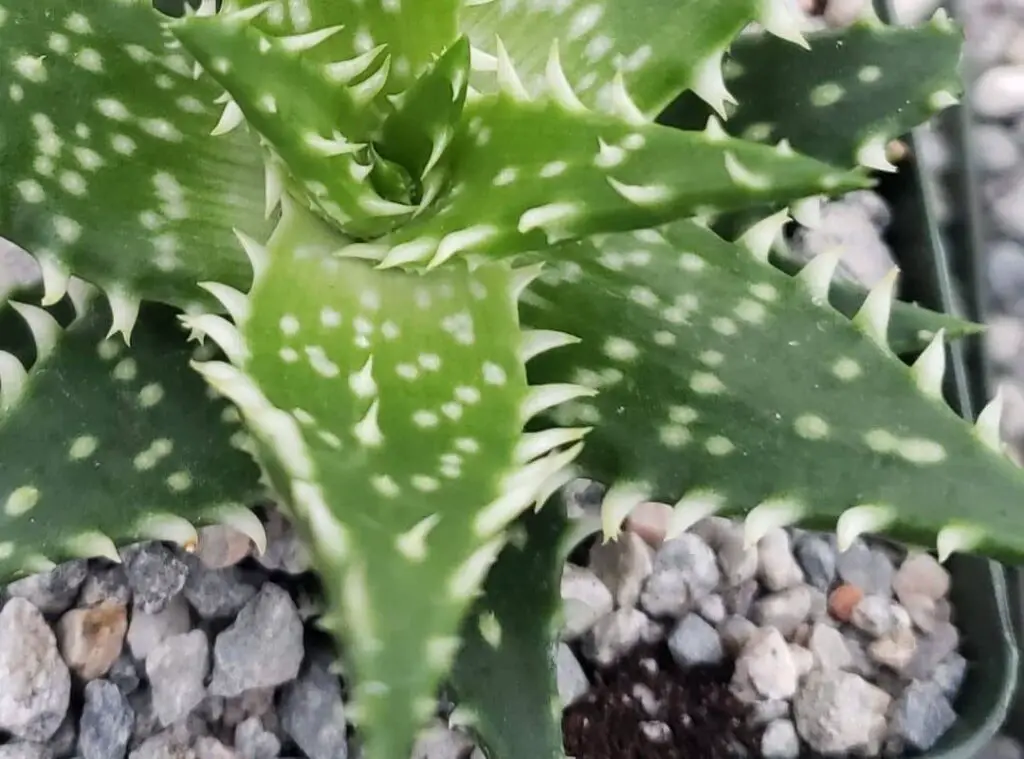
How to propagate Minnie Belle aloe
You may propagate these plants by using the seeds. You simply have to sow them in sandy soil. It will take a few weeks to see the results. You need to expose them to a temperature range of 68- and 75-degrees Fahrenheit. They would prefer to be moist but at the same time make sure you are using a well-draining soil mix too.
Apart from the above, you may also use the stem cuttings and offsets to propagate them. If you use the stem cuttings, you simply have to make the cuttings slightly below a node.
They have a high potential to root. Further when you make the cutting, you could be tactful in cutting a leggy stem.
Once you cut them off, you need to leave them in a warm and dry place where they can develop calluses. Next you may place them in a potting medium. Keep the soil medium moist until the rooting takes place.
Minnie Belle aloe plant benefits
Minnie belle aloe plants are useful as medicinal plants and decorative plants. They are further useful as a source of fuel as well. They would look very attractive when you grow them in pots or in containers. Further you could use them for succulent gardens as well.
To elaborate further on the medicinal value of these plants, Minnie belle aloe consists of a sap which you could use as a laxative to treat constipation.
In addition to that many people use these plants to treat gastrointestinal problems as well. Not only that but also, this is used as a remedy to treat cancer as well. Apart from that Minnie belle aloe are quite handy to use for livestock, particularly for the animals who have digestive problems.
Conclusion
So, now we have covered all the basic things you need to be aware of when growing Minnie belle aloe plants. Hope this was clear enough for you and trust it could enhance your knowledge on Minnie belle aloe plants. To sum up, what is important is to water them properly, expose them for proper sunlight and grow them in the right soil mix. These are easy to care for. So, if you manage to fulfill these basic growing requirements they will flourish well and grow as beautiful and vigorous plants.
Read Next: Graptopetalum Pachyphyllum ‘Blue bean’ Succulent Care Guide | 18 Facts |
